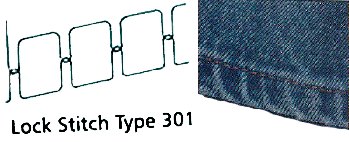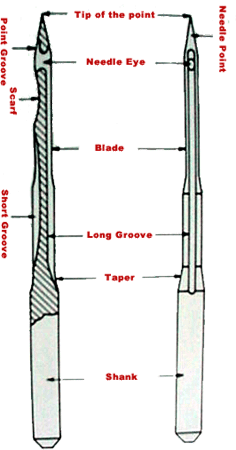Loop Strength of Thread
Seam failure in a woven fabric which is due to thread breakage could be said to be less of a problem than that due to fabric failure because it can at least be repaired. The majority of thread-breaks in a seam occur at a looped part of a stitch and the loop strength of a thread is more closely related to stitch strength than is linear tensile strength. Loop strength is the load required to break a length of thread which is looped through another thread of the same length and it is influenced by stiffness, fibre or filament type, ply and twist construction and regularity of these factors.
The measure of thread strength which most closely relates to stitch strength is minimum loop strength- the strength of the weakest loop in a series, tested in a continuous length of thread. Synthetic threads have higher loop strengths than cotton threads and technical developments have increased even these so that finer speciality thread (core spun threads) can now be used which have the same strength as coarser threads.
Stitch Density
Variations in stitch density affect seam strength and if other factors remain unchanged, then seam strength normally increases with stitch density up to a point where the concentration of needle holes starts to weaken the material. Alternatively, a stronger thread should be used at a lower stitch density. This will require a larger needle size with all the attendant problems of possible needle damage, emphasising again the need to use thread with higher specific strength so that the size of thread and consequently of needle can be used, consistent with other sewing properties.
Seam Stretch
SEAM ELASTICITY
With comfort stretch fabrics stretching up to 30 per cent and action stretch fabrics stretching 100 per cent or more, it is necessary to create seams which will stretch and recover in excess of this so that they do not restrict the flexibility of the garment or break at their limiting extension.
Stitch & Seam Type
Choice of stitch and seam type is very important. Both lock stitch 301 and chain stitch 401, if carefully adjusted, will give adequate stretch for sewing comfort stretch fabrics when used with superimposed or lapped seams. With lock stitch, there is a limit to the extent to which the stitch tension can be loosened to increase stretch and possible to set the stitch looser but only at the expense of an increase in seam ‘grinning’, a temporary appearance of the stitch opening up in the seam when stressed transversely.
This feature has given 401 the reputation of having higher stretch than 301. For action stretch fabrics and for cut-and-sew knitwear, it is not possible to achieve high enough stretch in a seam using stitch types 301 or 401. In many garments, a class 500 over edge stitch is acceptable, despite the bulky seam it inevitably produces.
The 504 three thread over edge stitch provides the maximum attainable extensibility. The length of the looper threads in the class 500 stitches, together with the compressibility of the enclosed fabric edges, enables these seams to extend to over 100 per cent without cracking.
Stitch Density
Increasing stitch density helps to increase seam stretch but only up to a certain point. In lockstitch seams, an increase in stitch density actually reduces the proportion of thread lying on the surface of the fabric and available for direct extension with the seam, unless thread tension is adjusted at the same time as the stitch is shortened.
With over edge stitches, increasing stitch density will increase seam stretch but a limit is reached when the fabric becomes jammed between the crowded stitches. Too many stitches may also weaken the fabric and cause failure under transverse stresses.
Seam Durability
Seam durability is the third aspect of seam performance originally identified as necessary to satisfactory seaming. The length of life of a seam in a garment should be as long as that of the other materials and both should be appropriate to the required end use of the garment. The seam can be considered to have failed in durability terms if either the thread or the fabric in the seam fails at an early stage. Jeans and work wear garments, underwear, school wear, etc.
all suffer considerable abrasion in wear and threads must be selected to resist this abrasion as effectively as possible. Duro soft i.e. Polyester/Cotton core spun threads are best known for their high abrasion resistance.
The durability of a thread in a seam depends on a tightness, seam type, thread type and the nature of the material being sewn. The critical factor is the extent to which the thread beds into the material. Seam sewn in a densely woven or coated material cannot bed in and are therefore more quickly abraded than those sewn into softer materials.
A different problem of seam durability and abrasion can arise with denim jeans when they are subjected to stonewashing. In this process they are severely abraded to produce a worn and faded look. Careful thread selection is required to prevent damage to seams requiring immediate repair or damage which shortens the life of the garment.
A satisfactory result can be obtained with DURO polyester/cotton core spun thread. A stitched component of a garment which is both functional and decorative and is subject to much abrasion is the buttonhole, especially when the button is being undone. Synthetic threads give greatly superior performance to cotton threads or polyester-covered core spun give both good durability and good appearance. The use of continuous filament button thread may significantly shorten the life of a spun fibre buttonhole thread by its abrasion
Seam Security
Seam security is another important seam performance factor. The securest of stitches, lockstitch, is formed by the interlocking of the threads together. If a thread breaks in a lockstitch seam, the stitches may run back for a short distance, depending on the longitudinal and transverse stress applied to the seam, the stretch in the fabric and the surface nature of the thread used. Additionally, the stitches can be back tacked at the end of the seam which makes the seam even more secure. The least secure stitches of all are the single thread chain stitches in class 100.




